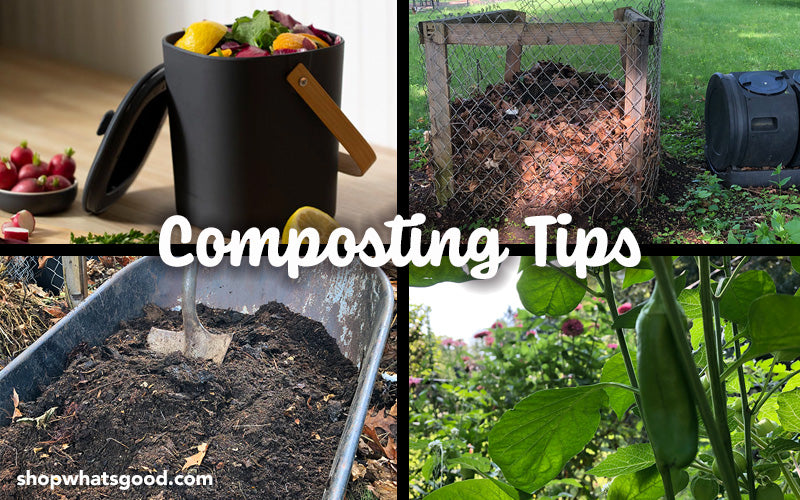FREE 🇺🇸 GROUND SHIPPING Orders 75+
FREE 🇺🇸 GROUND SHIPPING Orders 75+
Add description, images, menus and links to your mega menu
A column with no settings can be used as a spacer
Link to your collections, sales and even external links
Add up to five columns
Add description, images, menus and links to your mega menu
A column with no settings can be used as a spacer
Link to your collections, sales and even external links
Add up to five columns
Composting Tips
May 20, 2022 2 Comments

By Sherri Hamilton
There’s so much to love about compost! #1.) It’s an eco-friendly way to recycle your organic waste such as food scraps, yard clippings, and dead leaves, and it keeps those things out of the landfill where they would otherwise emit methane, one of the most potent of the greenhouse gases linked to global warming and climate change. #2.) Composting converts organic waste back into nutrient-rich soil which can then be used for gardens, around your flowers, added to potted plants, or simply to patch areas of your lawn and improve overall soil health.
Composting can be done at home with just a little corner of your yard, or your town may have a municipal compost collection service or drop-off site. You may also have commercial compost collection services available in your area. Check with your town or county for your local options.
If you choose to compost at home, here are 10 tips to ensure your success:
1.) Keep an air-tight canister or bucket in your kitchen to collect food scraps daily. You can keep it right out on the counter, wherever you do your food prep, or under the sink. Scraps can include fruit and vegetable peelings, stems, cores, eggshells, coffee grounds, flowers, and any produce that’s no longer edible. Do not include animal products such as meats, cheeses, bones, or fat, or any prepared foods containing oils or sauces.
2.) Designate a small outdoor area for your composting system. There are lots of forms this can take including an open-air bin, closed bin, buried trench, or tumbler bin system. We personally like DIY options for an open bin system using repurposed wood pallets and chicken wire (as pictured above). Whichever system you choose, when your indoor kitchen scrap container gets full, empty it outside in your composting system. Easy-peasy!
3.) Overall, the 4 key ingredients that make composting successful are AIR, WATER, GREENS & BROWNS.
4.) AIR = once your scraps are outdoors, odor won’t be an issue. You need air (specifically, oxygen) to help with decomposition. Aerate your pile by turning it with a pitch fork or shovel about once a week during the summer (less often in the winter).
5.) WATER = natural precipitation can often be enough, but if you live in a dry region, you’ll want to spray your pile with some water now and then. The moisture level of your pile, no matter what kind of system you have, should be similar to a wrung-out sponge. This will aid micro-organisms and the decomposition process.
6.) GREENS = this refers to the nitrogen-rich food scraps from your kitchen, and can also include fresh grass clippings, flowers, and garden waste.
7.) BROWNS - this refers to carbon-rich organic matter that’s already dried, such as dead leaves, straw, pine cones, dryer lint, and even newspaper (not glossy) and brown paper bags. Do not compost pet waste of any kind due to the potential for harmful bacteria or parasites.
8.) Prevent pests & critters from getting into your compost by keeping food scraps covered over with a layer of leaves, grass clippings, hay or straw.
9.) Then, just let your pile do its natural thing! You simply CAN NOT mess it up once nature takes charge. If you forget to keep it moist, the composting process still occurs, it may just take longer. Same goes for temperature. The optimal temperature for aerobic composting is around 130 degrees F. If your conditions are a little cooler, that’s fine. Again, the process just goes a little slower.
10.) The finished soil can be excavated out of the bottom of your system. The texture should be crumbly and smooth without any remnants of food scraps, and the color will be dark. And, it will be loaded with invisible nutrients!
There are lots of great resources to help you out. Including from us! Through the month of May, we’re giving away a FREE composting guide with every bin purchase.
Happy composting! 🥬
About Sherri Hamilton: Sherri is a What's Good® team member who actively composts at home with a tried-and-true open-air bin system and a recently acquired tumbler system (a hand-me-down from a friend, but she's net convinced yet on the complexity of it!). Sherri is also a volunteer member of the Color Fairport Green Food Waste Diversion & Composting Committee.
2 Responses
Anonymous
June 04, 2022
This is super. Question: you say to excavate the finished soil out of the bottom, is there a trick or mechanism on your bin? Is it possible to divide the bin in some way? Thank you!
Leave a comment

Good News
If any email is worthy of your inbox, it's this. Our goal is 1–2x per month. You'll get helpful & inspiring eco info, plus subscriber-only discounts.
Welcome to What's Good
Here's your $10 coupon
COPY THIS CODE TO USE IN CHECKOUT

Anonymous
June 04, 2022
This is super. Question: you say to excavate the finished soil out of the bottom, is there a trick or mechanism on your bin? Is it possible to divide the bin in some way? Thank you!